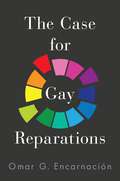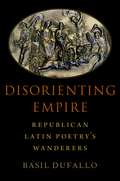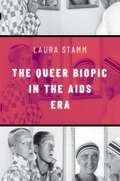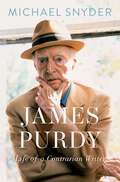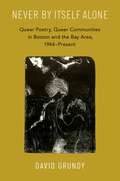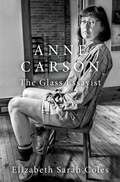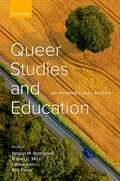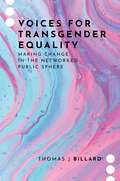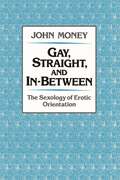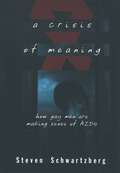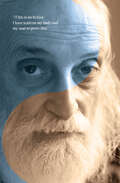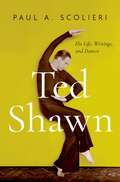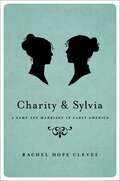- Table View
- List View
The Case for Gay Reparations
by Omar G. EncarnaciónA compelling and timely vision for gay reparations in the United States In the last two decades many nations have adopted "gay reparations," or policies intended to make amends for a history of discrimination, stigmatization, and violence on the basis of sexual orientation and gender identity. Far from being a homogenous or uniform phenomenon, gay reparations encompass a small constellation of approaches including a formal apology to the LGBT community for past wrongdoing, financial compensation for victims of anti-LGBT laws and actions, and the erection of monuments to the memory of those who suffered because of structural homophobia. The United States, however, has been reluctant to embrace gay reparations, making the country something of an outlier among Western democracies. Beyond making the case for gay reparations in the United States, this book explores a wide range of questions provoked by the rise of the gay reparations movement. Among these questions, three stand out for what they reveal about the puzzling and complex nature of this new front in the struggle for LGBT equality. Why, after centuries of attempts to marginalize, dehumanize, and even eradicate LGBT people, are governments coming around to confront this dark and painful historical legacy? How do we make sense of the diversity of gay reparations being implemented by governments around the world? And, finally, what would an American policy of gay reparations look like? Omar G. Encarnación draws upon the rich history of reparations to confront the legacies of genocide, slavery, and political repression and argue that gay reparations are a moral obligation intended to restore dignity to those whose human rights have been violated because of their sexual orientation and gender identity. Reparations are also necessary to close painful chapters of anti-LGBT discrimination and violence and to remind future generations of past struggles for LGBT equality. To this end, he traces America's dark and painful LGBT history--from colonial-era laws criminalizing homosexual conduct, to a postwar ban on homosexuals working in the federal bureaucracy, to the government's support of the junk-science underpinning the practice of "gay conversion" therapy promoted by the Christian Right. The book also examines how other Western democracies notorious for their repression of homosexuals--specifically Spain, Britain, and Germany--have implemented gay reparations. These foreign experiences reveal potential pathways for gay reparations in the United States. More importantly, they show that while there is no universal approach to gay reparations it is never too late for countries to seek to right past wrongs.
The Case for Gay Reparations
by Omar G. EncarnaciónA compelling and timely vision for gay reparations in the United States In the last two decades many nations have adopted "gay reparations," or policies intended to make amends for a history of discrimination, stigmatization, and violence on the basis of sexual orientation and gender identity. Far from being a homogenous or uniform phenomenon, gay reparations encompass a small constellation of approaches including a formal apology to the LGBT community for past wrongdoing, financial compensation for victims of anti-LGBT laws and actions, and the erection of monuments to the memory of those who suffered because of structural homophobia. The United States, however, has been reluctant to embrace gay reparations, making the country something of an outlier among Western democracies. Beyond making the case for gay reparations in the United States, this book explores a wide range of questions provoked by the rise of the gay reparations movement. Among these questions, three stand out for what they reveal about the puzzling and complex nature of this new front in the struggle for LGBT equality. Why, after centuries of attempts to marginalize, dehumanize, and even eradicate LGBT people, are governments coming around to confront this dark and painful historical legacy? How do we make sense of the diversity of gay reparations being implemented by governments around the world? And, finally, what would an American policy of gay reparations look like? Omar G. Encarnación draws upon the rich history of reparations to confront the legacies of genocide, slavery, and political repression and argue that gay reparations are a moral obligation intended to restore dignity to those whose human rights have been violated because of their sexual orientation and gender identity. Reparations are also necessary to close painful chapters of anti-LGBT discrimination and violence and to remind future generations of past struggles for LGBT equality. To this end, he traces America's dark and painful LGBT history--from colonial-era laws criminalizing homosexual conduct, to a postwar ban on homosexuals working in the federal bureaucracy, to the government's support of the junk-science underpinning the practice of "gay conversion" therapy promoted by the Christian Right. The book also examines how other Western democracies notorious for their repression of homosexuals--specifically Spain, Britain, and Germany--have implemented gay reparations. These foreign experiences reveal potential pathways for gay reparations in the United States. More importantly, they show that while there is no universal approach to gay reparations it is never too late for countries to seek to right past wrongs.
Experimental Film and Queer Materiality
by Juan A. Su?rezOften described as an art of abstraction and subjective introspection, experimental film is also invested in exploring daily objects and materials and in channeling, in the process, a peculiar perception of the modern everyday that this book calls queer materiality. Queer materiality designates the queer latency of modern material culture, which often inspired queer artists and filmmakers to envision wayward bodies and behaviors, and refers to the way in which sexual and social dissidence was embedded in the objects, technologies, substances, and spaces that make up the hardware of experience. This book studies a rich archive of queer material engagements in work by well-known filmmakers such as Andy Warhol, Barbara Hammer, Carolee Schneemann, and Jack Smith as well as under-recognized figures such as Tom Chomont, Jim Hubbard, Ashley Hans Scheirl, and Teo Hern?ndez. Combining history, formal analysis, and theoretical reflection, author Juan A. Su?rez shows how plastics, glitter, mechanical ensembles, urban ruins, garbage, amphetamine, film grain, and noise have been mobilized in the articulation of queerness for the screen. Experimental Film and Queer Materiality is an inquiry into the liveliness of matter and into the interface between sexuality and the material world.
Experimental Film and Queer Materiality
by Juan A. Su?rezOften described as an art of abstraction and subjective introspection, experimental film is also invested in exploring daily objects and materials and in channeling, in the process, a peculiar perception of the modern everyday that this book calls queer materiality. Queer materiality designates the queer latency of modern material culture, which often inspired queer artists and filmmakers to envision wayward bodies and behaviors, and refers to the way in which sexual and social dissidence was embedded in the objects, technologies, substances, and spaces that make up the hardware of experience. This book studies a rich archive of queer material engagements in work by well-known filmmakers such as Andy Warhol, Barbara Hammer, Carolee Schneemann, and Jack Smith as well as under-recognized figures such as Tom Chomont, Jim Hubbard, Ashley Hans Scheirl, and Teo Hern?ndez. Combining history, formal analysis, and theoretical reflection, author Juan A. Su?rez shows how plastics, glitter, mechanical ensembles, urban ruins, garbage, amphetamine, film grain, and noise have been mobilized in the articulation of queerness for the screen. Experimental Film and Queer Materiality is an inquiry into the liveliness of matter and into the interface between sexuality and the material world.
Disorienting Empire: Republican Latin Poetry's Wanderers
by Basil DufalloDisorienting Empire is the first book to examine Republican Latin poetry's recurring interest in characters who become lost. Basil Dufallo explains the prevalence of this theme with reference to the rapid expansion of Rome's empire in the Middle and Late Republic. It was both a threatening and an enticing prospect, Dufallo argues, to imagine the ever-widening spaces of Roman power as a place where one could become disoriented, both in terms of geographical wandering and in a more abstract sense connected with identity and identification, especially as it concerned gender and sexuality. Plautus, Terence, Lucretius, and Catullus, as well as the "triumviral" Horace of Satires, book 1, all reveal an interest in such experiences, particularly in relation to journeys into the Greek world from which these writers drew their source material. Fragmentary authors such as Naevius, Ennius, and Lucilius, as well as prose historians including Polybius and Livy, add depth and context to the discussion. Setting the Republican poets in dialogue with queer theory and postcolonial theory, Dufallo brings to light both anxieties latent in the theme and the exuberance it suggests over new creative possibilities opened up by reorienting oneself toward new horizons, new identifications-by discovering with pleasure that one could be other than one thought. Further, in showing that the Republican poets had been experimenting with such techniques for generations before the Augustan Age, Disorienting Empire offers its close readings as a means of interpreting afresh Aeneas' wandering journey in Vergil's Aeneid.
Disorienting Empire: Republican Latin Poetry's Wanderers
by Basil DufalloDisorienting Empire is the first book to examine Republican Latin poetry's recurring interest in characters who become lost. Basil Dufallo explains the prevalence of this theme with reference to the rapid expansion of Rome's empire in the Middle and Late Republic. It was both a threatening and an enticing prospect, Dufallo argues, to imagine the ever-widening spaces of Roman power as a place where one could become disoriented, both in terms of geographical wandering and in a more abstract sense connected with identity and identification, especially as it concerned gender and sexuality. Plautus, Terence, Lucretius, and Catullus, as well as the "triumviral" Horace of Satires, book 1, all reveal an interest in such experiences, particularly in relation to journeys into the Greek world from which these writers drew their source material. Fragmentary authors such as Naevius, Ennius, and Lucilius, as well as prose historians including Polybius and Livy, add depth and context to the discussion. Setting the Republican poets in dialogue with queer theory and postcolonial theory, Dufallo brings to light both anxieties latent in the theme and the exuberance it suggests over new creative possibilities opened up by reorienting oneself toward new horizons, new identifications-by discovering with pleasure that one could be other than one thought. Further, in showing that the Republican poets had been experimenting with such techniques for generations before the Augustan Age, Disorienting Empire offers its close readings as a means of interpreting afresh Aeneas' wandering journey in Vergil's Aeneid.
The Queer Biopic in the AIDS Era
by Laura StammThe Queer Biopic in the AIDS Era offers a new account of the AIDS crisis and the emergence of New Queer Cinema. Author Laura Stamm asks why queer filmmakers repeatedly produced biographical films of queer individuals living and dead throughout the years surrounding the AIDS crisis. Queer filmmakers' engagement with the biopic evokes the genre's history of building life through the portrayal of lives worthy of admiration and emulation but it also points to another biopic history; that of representing lives damaged. By portraying lives damaged by inconceivable loss, queer filmmakers challenge the illusion of a coherent self presumably reinforced by the biopic genre and in doing so, their films open the potential for new means of connection and relationality. The Queer Biopic in the Aids Era features fresh readings of the cinema of Derek Jarman, John Greyson, Todd Haynes, Barbara Hammer, and Tom Kalin. By calling for a reappraisal of the queer biopic, this book also calls for a reappraisal of New Queer-Cinema's legacy and its influence of contemporary queer film. As a whole, this book pays particular attention to the biopic's queer resonances, opening up its historical connections to projects of education, public health, and social hygiene, along with the production of a shared history and national identity.
The Queer Biopic in the AIDS Era
by Laura StammThe Queer Biopic in the AIDS Era offers a new account of the AIDS crisis and the emergence of New Queer Cinema. Author Laura Stamm asks why queer filmmakers repeatedly produced biographical films of queer individuals living and dead throughout the years surrounding the AIDS crisis. Queer filmmakers' engagement with the biopic evokes the genre's history of building life through the portrayal of lives worthy of admiration and emulation but it also points to another biopic history; that of representing lives damaged. By portraying lives damaged by inconceivable loss, queer filmmakers challenge the illusion of a coherent self presumably reinforced by the biopic genre and in doing so, their films open the potential for new means of connection and relationality. The Queer Biopic in the Aids Era features fresh readings of the cinema of Derek Jarman, John Greyson, Todd Haynes, Barbara Hammer, and Tom Kalin. By calling for a reappraisal of the queer biopic, this book also calls for a reappraisal of New Queer-Cinema's legacy and its influence of contemporary queer film. As a whole, this book pays particular attention to the biopic's queer resonances, opening up its historical connections to projects of education, public health, and social hygiene, along with the production of a shared history and national identity.
James Purdy: Life of a Contrarian Writer
by Michael SnyderA New Yorker Best Book of 2022 A definitive biography of a twentieth century gay author whose work has recently been rediscovered and enjoys a cult following. One of the most iconoclastic twentieth-century American novelists, James Purdy penned original and sometimes shocking works about those on the margins of American society, exploring small towns, urban life, failure, alienation, sexuality, and familial relations. In his own life, Purdy was a compelling if eccentric figure, declared an "authentic American genius" by Gore Vidal. James Purdy: Life of a Contrarian Writer is the first full-length biography of the gay American novelist, story writer, playwright, and poet. Michael Snyder has spent over a decade plumbing the mysteries of Purdy's career and personal life, including interviews with those who knew him. From his roots in northwestern Ohio, Purdy moved to the world of Bohemian artists and jazz musicians in Chicago in the late 1930s and 1940s, travelled in Spain, studied in Mexico, enlisted in the Army Air Corps, worked for the Federal Security Agency, and taught in Cuba and at a Wisconsin college for nearly a decade. All the while, he aspired to become a writer, but struggled to publish. Only when friends financed the private printing of his work did he find a champion in poet Dame Edith Sitwell, who helped get him published in England, which led to publication in the United States. After moving to New York in 1957, he spent nearly fifty years writing in Brooklyn Heights. Although Purdy's critical reputation peaked in the 1960s and he never enjoyed a bestseller, his often queer and edgy content found a diverse following that included Tennessee Williams, Langston Hughes, William Carlos Williams, Dorothy Parker, Edward Albee, Jonathan Franzen, John Waters, and many LGBTQ readers. Difficult and often contrarian, Purdy sometimes hampered his own career as he sought recognition from a conservative, cliquey New York publishing world. Conveying the potency and influence of Purdy's fierce artistic integrity, vision, and self-definition as a truth-teller, this groundbreaking literary biography recovers the life of a highly talented writer with a persistent cult following.
James Purdy: Life of a Contrarian Writer
by Michael SnyderA definitive biography of a twentieth century gay author whose work has recently been rediscovered and enjoys a cult following. One of the most iconoclastic twentieth-century American novelists, James Purdy penned original and sometimes shocking works about those on the margins of American society, exploring small towns, urban life, failure, alienation, sexuality, and familial relations. In his own life, Purdy was a compelling if eccentric figure, declared an "authentic American genius" by Gore Vidal. James Purdy: Life of a Contrarian Writer is the first full-length biography of the gay American novelist, story writer, playwright, and poet. Michael Snyder has spent over a decade plumbing the mysteries of Purdy's career and personal life, including interviews with those who knew him. From his roots in northwestern Ohio, Purdy moved to the world of Bohemian artists and jazz musicians in Chicago in the late 1930s and 1940s, travelled in Spain, studied in Mexico, enlisted in the Army Air Corps, worked for the National Security Agency, and taught in Cuba and at a Wisconsin college for nearly a decade. All the while, he aspired to become a writer, but struggled to publish. Only when friends financed the private printing of his work did he find a champion in poet Dame Edith Sitwell, who helped get him published in England, which led to publication in the United States. After moving to New York in 1957, he spent nearly fifty years writing in Brooklyn Heights. Although Purdy's critical reputation peaked in the 1960s and he never enjoyed a bestseller, his often queer and edgy content found a diverse following that included Tennessee Williams, Langston Hughes, William Carlos Williams, Dorothy Parker, Edward Albee, Jonathan Franzen, John Waters, and many LGBTQ readers. Difficult and often contrarian, Purdy sometimes hampered his own career as he sought recognition from a conservative, cliquey New York publishing world. Conveying the potency and influence of Purdy's fierce artistic integrity, vision, and self-definition as a truth-teller, this groundbreaking literary biography recovers the life of a highly talented writer with a persistent cult following.
Never By Itself Alone: Queer Poetry, Queer Communities in Boston and the Bay Area, 1944?Present
by David GrundyProviding an unprecedented exploration of key moments in queer literary history, Never By Itself Alone changes our sense of both the American literary and political landscapes from the late 1940s through the 21st century. Grundy presents the first comprehensive history of post-war queer writing in Boston and San Francisco, intertwining analysis of lesbian, gay, and queer writing, and insisting on the link between activism and literature. The book centers a host of underrepresented writers, especially writers of color and those with gender non-conforming identities, and challenges the Stonewall exceptionalism of queer historiography. Starting with Robert Duncan's 1944 essay, 'The Homosexual in Society', one of the first significant public defenses of homosexuality in the US, Grundy takes the reader through pioneering works by queer voices of the era, including Adrian Stanford's Black and Queer, the first published book by an out, Black gay poet in the US; the Boston collective Fag Rag and their radical reconsideration of family, private property and the State; the Combahee River Collective, whose Black Feminist analysis drew together race, class, and sexuality; the anthology This Bridge Called My Back, in which women of color spoke truth to power, together; and New Narrative writing, which audaciously mixed Marxism, porn and gossip while uniting against the New Right. Linking these works to the context which produced them, Grundy uncovers the communities formed around activism and small press publishing during this era and elevates neglected voices to narrate a history that before now has never been told in its entirety. Drawing on extensive archival research, Never By Itself Alone is a rigorous and unmatched work of both literary criticism and queer scholarship which underscores the vital importance of radical accounts of race, class, and gender in any queer studies worthy of the name.
Never By Itself Alone: Queer Poetry, Queer Communities in Boston and the Bay Area, 1944?Present
by David GrundyProviding an unprecedented exploration of key moments in queer literary history, Never By Itself Alone changes our sense of both the American literary and political landscapes from the late 1940s through the 21st century. Grundy presents the first comprehensive history of post-war queer writing in Boston and San Francisco, intertwining analysis of lesbian, gay, and queer writing, and insisting on the link between activism and literature. The book centers a host of underrepresented writers, especially writers of color and those with gender non-conforming identities, and challenges the Stonewall exceptionalism of queer historiography. Starting with Robert Duncan's 1944 essay, 'The Homosexual in Society', one of the first significant public defenses of homosexuality in the US, Grundy takes the reader through pioneering works by queer voices of the era, including Adrian Stanford's Black and Queer, the first published book by an out, Black gay poet in the US; the Boston collective Fag Rag and their radical reconsideration of family, private property and the State; the Combahee River Collective, whose Black Feminist analysis drew together race, class, and sexuality; the anthology This Bridge Called My Back, in which women of color spoke truth to power, together; and New Narrative writing, which audaciously mixed Marxism, porn and gossip while uniting against the New Right. Linking these works to the context which produced them, Grundy uncovers the communities formed around activism and small press publishing during this era and elevates neglected voices to narrate a history that before now has never been told in its entirety. Drawing on extensive archival research, Never By Itself Alone is a rigorous and unmatched work of both literary criticism and queer scholarship which underscores the vital importance of radical accounts of race, class, and gender in any queer studies worthy of the name.
Anne Carson: The Glass Essayist
by Elizabeth Sarah ColesThe scholar is transparent and accountable, the poet inward and errant: anyone who reads Anne Carson has to suspend many such separations of power. The first monographic study of her work to date, Anne Carson: The Glass Essayist makes the case for the acclaimed poet, classicist, and translator as a remarkable experimental scholar and reader, who rehearses scholarly methods while slipping their constraints of form and emotion. Carson's attention to sources-ancient and modern, textual or visual-is one of few constants across almost four decades of her published writing, whose uncertain claims on discipline and genre are claimed here as a certain interpretive style. The book follows Carson's readings through variations in form-from early academic prose and poem-essays to creative adaptations and works for performance-to come to grips with what Coles calls Carson's transparency: not her easiness or literalism, but a taste for the exposure of her presence, process, and intent. Carson's portraits of working perform to readers even where she fantasizes her own erasure; where chance, poetic economy, impersonation, and imitation ride the line of anonymity. Coles situates Carson in a vibrant contemporary conversation around the essay, scholar-poets, and post-critical form, where creation transacts critique, and where roles and prerogatives are reset. Reading Carson as a reader, the book argues, is the most pressing way of reading her now.
Anne Carson: The Glass Essayist
by Elizabeth Sarah ColesThe scholar is transparent and accountable, the poet inward and errant: anyone who reads Anne Carson has to suspend many such separations of power. The first monographic study of her work to date, Anne Carson: The Glass Essayist makes the case for the acclaimed poet, classicist, and translator as a remarkable experimental scholar and reader, who rehearses scholarly methods while slipping their constraints of form and emotion. Carson's attention to sources-ancient and modern, textual or visual-is one of few constants across almost four decades of her published writing, whose uncertain claims on discipline and genre are claimed here as a certain interpretive style. The book follows Carson's readings through variations in form-from early academic prose and poem-essays to creative adaptations and works for performance-to come to grips with what Coles calls Carson's transparency: not her easiness or literalism, but a taste for the exposure of her presence, process, and intent. Carson's portraits of working perform to readers even where she fantasizes her own erasure; where chance, poetic economy, impersonation, and imitation ride the line of anonymity. Coles situates Carson in a vibrant contemporary conversation around the essay, scholar-poets, and post-critical form, where creation transacts critique, and where roles and prerogatives are reset. Reading Carson as a reader, the book argues, is the most pressing way of reading her now.
Queer Studies and Education: An International Reader
Queer Studies and Education: An International Reader explores how the category queer, as a critical stance or set of perspectives, contributes to opportunities individually and collectively for advancing queer social justice within the context and concerns of schooling and education. The collection takes up this general goal by presenting a cross-section of international perspectives on queer studies in education to demonstrate commonalities, differences, uncertainties, or pluralities across a diverse range of national contexts and topics, drawing a heightened awareness of heterodominance and heteropatriarchy, and to conceptualize non-normative and non-essentialist imaginings for more inclusive educational environments. Collectively, the chapters critically engage with heteronormativity and normativity more generally as a political spectrum, over a broad range of formal and informal sites of education, and against a backdrop of critiques of liberalism and neoliberalism as the frameworks through which "achievable" social change and belonging are fostered, particularly within educational settings. Taken together, the chapters assembled in Queer Studies and Education invite researchers, scholars, educators, activists, and other cultural workers to examine the multiplicity of contemporary (international) work in queer studies and education with readers' interpretations of queer's deployment across the chapters forming the compass for which to arrive at fresh insights and forms of queer critical praxis.
Queer Studies and Education: An International Reader
by Nelson M. Rodriguez, Robert C. Mizzi, Louisa AllenQueer Studies and Education: An International Reader explores how the category queer, as a critical stance or set of perspectives, contributes to opportunities individually and collectively for advancing (queer) social justice within the context and concerns of schooling and education. The collection takes up this general goal by presenting a cross-section of international perspectives on queer studies in education to demonstrate commonalities, differences, uncertainties, or pluralities across a diverse range of national contexts and topics, drawing a heightened awareness of heterodominance and heteropatriarchy, and to conceptualize non-normative and non-essentialist imaginings for more inclusive educational environments. Collectively, the chapters critically engage with heteronormativity and normativity more generally as a political spectrum, over a broad range of formal and informal sites of education, and against a backdrop of critiques of liberalism and neoliberalism as the frameworks through which "achievable" social change and belonging are fostered, particularly within educational settings. Taken together, the chapters assembled in Queer Studies and Education invite researchers, scholars, educators, activists, and other cultural workers to examine the multiplicity of contemporary (international) work in queer studies and education with readers' interpretations of queer's deployment across the chapters forming the compass for which to arrive at fresh insights and forms of (queer) critical praxis.
Feeling Singular: Queer Masculinities in the Early United States
by Ben BascomMuch of U.S. cultural production since the twentieth century has celebrated the figure of the singular individual, from the lonesome Huckleberry Finn to the cinematic loners John Wayne and Clint Eastwood, but that tradition casts a backward shadow that prohibits seeing how the singular in America was previously marked as unwanted, outcast, excessive, or weird. Feeling Singular: Queer Masculinities in the Early United States examines the paradoxical nature of masculine self-promotion and individuality in the early United States. Through a collection of singular life narratives, author Ben Bascom draws on a queer studies approach that uncovers how fraught private desires shaped a public masculinity increasingly at odds with the disinterested norms of republican public culture. In telling the stories of excessive American masculinities, Feeling Singular presents the Early Republic of the United States as a queer and messy world of social outcasts and eccentric personalities all vying--and in spectacular ways failing--for public attention. These figures include John Fitch (1743-1798), a struggling working-class mechanic; Jeffrey Brace (1742-1827), a formerly enslaved Black Revolutionary War veteran; Timothy Dexter (1747-1806), a self-declared "Lord" who secured a fortune through a risky venture in bedpans and whalebone corsets; Jonathan Plummer (1761-1819), an itinerant peddler and preacher; and William "Amos" Wilson (1762-1821), a reclusive stonecutter who became popularly known as "the Pennsylvania Hermit." Despite leaving behind copious manuscripts and printed autobiographies, they dwindled instead into cultural insignificance, failing to achieve what scholars have called the hallmarks of "republican masculinity." Through closely reading a range of texts--from manuscripts to hastily printed books, and from phonetically spelled pamphlets to sexually explicit broadsides--Bascom uses the language of queer studies to understand what made someone singular in the early United States and how that singularity points at the ruptures in social codes that get normalized through historical analysis. Departing from the likes of Benjamin Franklin, whom tradition positions as a paragon of self-production, this book offers instead typologies of the failed inventor, the tragic outsider, the flamboyant pretender, the farcical exhorter, and the disaffected exile.
Voices for Transgender Equality: Making Change in the Networked Public Sphere (Journalism and Political Communication Unbound)
by Thomas J BillardTransgender rights have emerged as an important topic of everyday conversation across the country in recent years and become, in many ways, the flashpoint du jour of the American culture wars. During the Trump presidency in particular, transgender people were thrust onto the center stage of US politics. Faced with unrelenting hostility and an increasingly complicated media system, transgender activists crafted new communication strategies to fight for their equality, stall attempts to undermine their rights, and win the support of large swathes of the public. In Voices for Transgender Equality, Thomas J Billard offers an insider's view into transgender activism during the first two years of the Trump administration. Drawing on extensive on-the-ground observation at the National Center for Transgender Equality, Billard shows how these activists developed an unlikely blend of online and offline strategies to saturate a diverse ecology of national news outlets, local and community media outlets across the country, and both public and private conversations across multiple social media platforms with voices in support of their cause. Moreover, these activists navigated the complex flows of information and ideas among these different domains of the communication system as they worked to shape the national conversation on transgender rights. As Billard argues, this movement occurred at a very particular time in the development of the media system, with "new" media shaping the movement in important ways that are both generalizable to other social movements and unique to transgender activism. Including rich storytelling and insightful analysis, Voices for Transgender Equality makes a compelling case of what it takes to make social and political change in a world transformed by digital media. Along the way, Billard provides key insights into the new business-as-usual of mediated politics and valuable lessons for more effective activism.
Beautiful: The Story of Julian Eltinge, America's Greatest Female Impersonator
by Andrew L. ErdmanFrom the late 19th to the early 21st centuries, female impersonation was a hugely popular performance genre. Long before today's popular television shows, men in colleges, business, and even the military formed drag clubs and put on musicals and variety shows of all kinds with little fear of negative judgment. But no female impersonator was as famous, successful, or highly-regarded as Julian Eltinge (1881-1941). Eltinge, born William Dalton just outside Boston, started playing female characters and imitating women with his mother's encouragement as a child while his father shuttled his family around the Americas in search of a mining fortune that never materialized. The future drag star returned to Boston in his late teens where he quickly rose through the ranks of semi-amateur all-male musicals, then transitioned to vaudeville, and eventually starred in hugely successful musical comedies such as The Fascinating Widow (1910). For decades, the Julian Eltinge Theatre on West 42nd Street bore testament to his stature. But Eltinge longed to play serious roles which did not require him to impersonate women; it was a lifelong struggle. He constructed a hypermasculine offstage persona-- a cigar-loving former Harvard athlete who beat up anyone who questioned his manliness--most of which wasn't true. But Eltinge's efforts were essential in a culture increasingly focused on separating ?real men? from ?inverts? and ?perverts,? demanding men define themselves in new ways during a time of economic and cultural upheaval. During his heyday, Eltinge published a beauty and advice magazine for women, launched lifestyle-brand makeup and skincare products, and became a paid spokesperson for corsets and women's shoes, all without a hint of irony. Julian Eltinge's success with mainstream audiences, ever avoiding suspicions and scandal, says much about the emergent middle-class white heteronormativity of the era and what we have come to think of as the social construction of gender. Beautiful pays tribute to Eltinge and gives rich insight into his unique contributions to the transformation of cultural ideas about masculinity and femininity.
Gay, Straight, and In-Between: The Sexology of Erotic Orientation
by John MoneyThe diverse historical, cultural, and physiological influences that determine sexual orientation are the focus of this fascinating work by one of the foremost investigators of human sexuality. Drawing on case studies from his sexology clinic, the author explores such topics as prenatal and postnatal history, gender differentiation in childhood, and postpubertal hormonal theories. In so doing, he addresses the many enigmas of sexual orientation: What makes some children grow up to be homosexual, while others become heterosexual or bisexual? To what degree is gender identity determined before birth? How do the concepts of masculine and feminine become differentiated during childhood? What do we know about the relationship between hormones and homosexuality in adulthood? A unique feature of this book is the follow-up reporting on Money's long-term studies that began over three decades ago. The studies are brought together here for comparison with one another--and with the work of others--and their full significance is systematically evaluated. Also explored here is his pioneering concepts of lovemaps, the pathways of individual sexual and erotic development, and the factors that may shape overall healthy or pathological orientation, paraphilia, and gender transposition in childhood, adolescence, and maturity. Written in accessible language for researchers and clinicians, this authoritative work is both thought-provoking and informative as it explores timely questions of sexual orientation.
A Crisis of Meaning: How Gay Men Are Making Sense of AIDS
by Steven SchwartzbergFor gay men, the demands of the AIDS epidemic are enormous and unrelenting. Regardless of HIV status, all are called on to maintain vigilant safety with sex, to face down a cultural stigma greater even than homophobia, and to somehow find a way to go forward in a world heavy with loss. As exhaustion and grief threaten to overwhelm the activism and optimism of earlier years, and with new infections on the rise among young gay men, the challenge of finding meaning in a world turned upside down is more than an idle philosophical exercise. It is a matter of psychological and perhaps even physical survival. In this poignant and uncompromising new book, Dr. Steven Schwartzberg offers a ground-breaking perspective on how gay men (and particularly HIV-positive gay men) find ways to rebuild a world of meaning amid the trauma and uncertainty of the AIDS crisis. Eschewing both glib prescriptions for turning tragedy into triumph, and theoretical abstractions, Schwartzberg grounds his insights in his own experiences as a gay man and as a practicing psychotherapist, and in in-depth interviews with nineteen men living with HIV. Ranging in age from twenty-seven to fifty, the men include a construction foreman, a physician, an art historian, a waiter, a librarian, and a licensed massage therapist. With candor, insight, eagerness, and a remarkable ability to share of themselves, they speak eloquently about how HIV has affected their views of the world, their senses of themselves, and how they live their lives. Interweaving the men's stories with observations from his research and clinical practice, Schwartzberg bears witness to the remarkable transformations some men have accomplished, and the anguish of meaninglessness that weighs others down. He strives to uncover why some view HIV as a catalyst for change or growth, while others see it only as punishment. And though he passes no judgment on the coping strategies he describes, Schwartzberg does insist on the vital necessity of balancing somber reality with healing, life-sustaining hope. He argues that men who opt for too much illusion and too little reality risk shoddy self-care and inadequate preparation for the future, while those who find no escape from reality may teeter into rage or suicidal despair. Beautifully written, with piercing awareness of the enormity of the challenges confronting individuals with HIV, this book celebrates the resilience of the human spirit. It is both a keen psychological guide and an elegiac chronicle of what life for many has become. Gently pointing the way to an oasis of growth, strength, and love that exists amid the epidemic's bleak terrain of loss, it is essential reading for people living with HIV, for their friends, families, and the mental health professionals who care for them, and for all gay men grappling with the enormous changes AIDS has brought to a community under siege.
Secret Writings of Hoshang Merchant
by Akshaya K. RathNever a shrinking violet, Hoshang Merchant came out of the closet early in his youth. A bard, a teacher, and a lover who has lived many lives, he is the quintessential gay who once cross-dressed, and yet defies categorization. In Secret Writings, he recounts his extraordinary life and splendid experiences ranging across countries and cultures. His is a story of the prejudice and neglect that are part of everyday gay life, and how he channelled his despair into creating poetry. He quotes Rumi, Ghalib, and Mir, and writes with searing honesty about his long and short love affairs, his ‘improbable’ sex life as both an initiator and a yielding partner, and his inner turmoil. Sex becomes love and love becomes poetry in his writing. Merchant yells at the moral guardians of law and culture, asks uncomfortable questions, and shocks his readers. This rare book opens a window to the myriad worlds of an avant-garde.
Ted Shawn: His Life, Writings, and Dances
by Paul A. ScolieriTed Shawn (1891-1972) is the self-proclaimed "Father of American Dance" who helped to transform dance from a national pastime into theatrical art. In the process, he made dancing an acceptable profession for men and taught several generations of dancers, some of whom went on to become legendary choreographers and performers in their own right, most notably his protégés Martha Graham, Louise Brooks, Doris Humphrey, and Charles Weidman. Shawn tried for many years and with great frustration to tell the story of his life's work in terms of its social and artistic value, but struggled, owing to the fact that he was homosexual, a fact known only within his inner circle of friends. Unwilling to disturb the meticulously narrated account of his paternal exceptionalism, he remained closeted, but scrupulously archived his journals, correspondence, programs, photographs, and motion pictures of his dances, anticipating that the full significance of his life, writing, and dances would reveal itself in time. Ted Shawn: His Life, Writings, and Dances is the first critical biography of the dance legend, offering an in-depth look into Shawn's pioneering role in the formation of the first American modern dance company and school, the first all-male dance company, and Jacob's Pillow, the internationally renowned dance festival and school located in the Berkshires. The book explores Shawn's writings and dances in relation to emerging discourses of modernism, eugenics and social evolution, revealing an untold story about the ways that Shawn's homosexuality informed his choreographic vision. The book also elucidates the influences of contemporary writers who were leading a radical movement to depathologize homosexuality, such as the British eugenicist Havelock Ellis and sexologist Alfred Kinsey, and conversely, how their revolutionary ideas about sexuality were shaped by Shawn's modernism.
Ted Shawn: His Life, Writings, and Dances
by Paul A. ScolieriTed Shawn (1891-1972) is the self-proclaimed "Father of American Dance" who helped to transform dance from a national pastime into theatrical art. In the process, he made dancing an acceptable profession for men and taught several generations of dancers, some of whom went on to become legendary choreographers and performers in their own right, most notably his protégés Martha Graham, Louise Brooks, Doris Humphrey, and Charles Weidman. Shawn tried for many years and with great frustration to tell the story of his life's work in terms of its social and artistic value, but struggled, owing to the fact that he was homosexual, a fact known only within his inner circle of friends. Unwilling to disturb the meticulously narrated account of his paternal exceptionalism, he remained closeted, but scrupulously archived his journals, correspondence, programs, photographs, and motion pictures of his dances, anticipating that the full significance of his life, writing, and dances would reveal itself in time. Ted Shawn: His Life, Writings, and Dances is the first critical biography of the dance legend, offering an in-depth look into Shawn's pioneering role in the formation of the first American modern dance company and school, the first all-male dance company, and Jacob's Pillow, the internationally renowned dance festival and school located in the Berkshires. The book explores Shawn's writings and dances in relation to emerging discourses of modernism, eugenics and social evolution, revealing an untold story about the ways that Shawn's homosexuality informed his choreographic vision. The book also elucidates the influences of contemporary writers who were leading a radical movement to depathologize homosexuality, such as the British eugenicist Havelock Ellis and sexologist Alfred Kinsey, and conversely, how their revolutionary ideas about sexuality were shaped by Shawn's modernism.
Charity and Sylvia: A Same-Sex Marriage in Early America
by Rachel Hope ClevesConventional wisdom holds that same-sex marriage is a purely modern innovation, a concept born of an overtly modern lifestyle that was unheard of in nineteenth century America. But as Rachel Hope Cleves demonstrates in this eye-opening book, same-sex marriage is hardly new. Born in 1777, Charity Bryant was raised in Massachusetts. A brilliant and strong-willed woman with a clear attraction for her own sex, Charity found herself banished from her family home at age twenty. She spent the next decade of her life traveling throughout Massachusetts, working as a teacher, making intimate female friends, and becoming the subject of gossip wherever she lived. At age twenty-nine, still defiantly single, Charity visited friends in Weybridge, Vermont. There she met a pious and studious young woman named Sylvia Drake. The two soon became so inseparable that Charity decided to rent rooms in Weybridge. In 1809, they moved into their own home together, and over the years, came to be recognized, essentially, as a married couple. Revered by their community, Charity and Sylvia operated a tailor shop employing many local women, served as guiding lights within their church, and participated in raising their many nieces and nephews. Charity and Sylvia is the intimate history of their extraordinary forty-four year union. Drawing on an array of original documents including diaries, letters, and poetry, Cleves traces their lives in sharp detail. Providing an illuminating glimpse into a relationship that turns conventional notions of same-sex marriage on their head, and reveals early America to be a place both more diverse and more accommodating than modern society might imagine, Charity and Sylvia is a significant contribution to our limited knowledge of LGBT history in early America.
